|
So the lady leans over and her face gets a little lemony and she’s thinking about a guy she really didn’t like much at all. Richard Widmark. Eh.
“The way he giggled in the movie where he pushed Mildred Dunnock down the stairs? That was his real giggle. He quit the show on a Friday. We went out in the hall outside the studio, and he -”
No. Save that story. But I will say I got the feeling she ranked him a solid 9 on the Ameche scale of men she was content to outlive.
Try again; new lede.
Yes, yes, everyone loves Lucy. You got‘ splainin’ to do, Waaaah, megavitaminawhatever, and so on. Everyone loves the Kramdens. Yes, yes: to the moon, Alice, one of these days, heya Ralphie Boy, hamina hamina hamina. Honeymooner catchphrases: they’re funny because, well, Honeymooners! I know everyone loves “Leave it to Beaver” because . . . well, no lines stand out, no plots can be recollected, but hey, the Beav! Ha ha. Gee dad and all that.
But what if there was a 50s TV comedy that rarely stooped to a laff line, let the comedy arise from character interactions that were absolutely normal but tweaked until the amusement compounded, bowled over every critic in the press, and was picked up by one network the moment another was stupid enough to drop it? What if there was a smart, expertly acted show whose star was the writer, and who’d been honing the repartee with her co-star for years in radio - and what if this show had never been seen since it aired in the late fifties?
Oh, cut the high-flown rhetorical postulates. Try again:
It’s not unusual for people to put up amusing illustrated vignettes in the bathroom, but when you realize that they’re original drawings by Whitney Darrow Jr., you -
No; needs context.
Okay. I give up. I don't know the right way into this story yet. So here:
I flew to New Hampshire, rented a car, drove up to Massachusetts and spent a few days at the home of Peg Lynch, the utterly brilliant radio and TV writer / actress whose work in the 40s and 50s is sharp and timeless and deserves to be known by everyone interested in smiling or laughing. Does that cover most of us gathered here today?
Herewith the whole account. If you want to skip the travel portion, the whole getting-there-is-half-the-fun part, it's below the ad.
THURSDAY
AIRPORT
I set four alarms. Two on the iPhone and the plain-but-bulletproof default clock app. I set the iPad on the bathroom counter, timed to go off a minute after the second alarm on the first phone. I set the computer in the next room to wail holy hell at four minutes past the hour. I got up twice in the middle of the night to check the time, certain that I’d overslept. Had to be up at 5:00. Had to catch a plane.
Woke with a start, certain I’d heard the alarm - but I’d only dreamed it. Checked the phone:
4:57 AM
Hah! Victory! I woke up before you could fail me! I win! I win! Somehow showered and dressed and somehow found the car and left the house as the skies lightened, off on the great adventure.
Okay; they’re calling for boarding. This is more I’ve written before 6:30 AM in the last 20 years.
DEEP IN THE BERKSHIRES
I’m here:

At a B&B. The owner is has gone down to the pond to let the dog have a dunk. The plane ride was remarkably brief, but I spent the entire time leaning allll the way over to the left because the guy in the other seat had been saturated with Generic Men’s Deodorant Aroma and - this was worse - had arm hair in such copious amounts that any attempt to fill out the entirely of MY space meant contact with the wispy tendrils. Landed, got the rental, hit the road. No highways up here. Only county roads, rarely more than two lanes, sometimes one: when there’s construction you just stop and wait.
Paused in Westfiel to cower in the historical disapproval of a Revolutionary War hero:
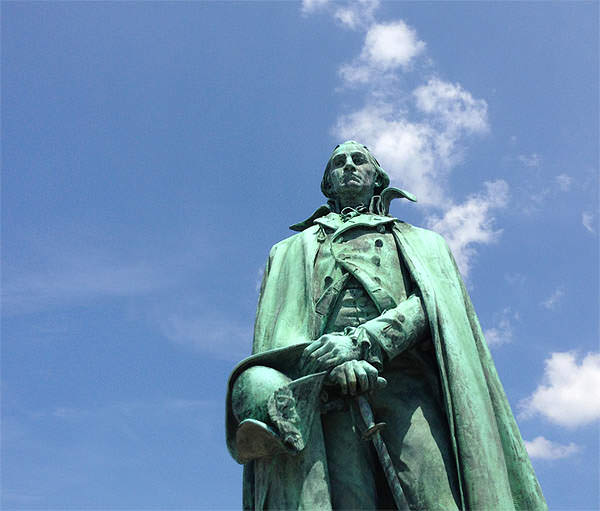
Nice little public square; hot as the frickin’ dickins, too. It’s 96, and it’s that East Coast heat, too. In Minnesota heat and humidity go together hand in glove, but on the East Coast it always feels like insult added to injury.
Stopped at a pizza joint for a slice.

There was one condiment on the table: ketchup.
Back on the road. Winding roads, never a moment of straightaway, marvelous views. You keep thinking: why is there a road here? Why are there people here? The work involved in making the road, building a town, it just seems so extraordinarily difficult compared to the straight-line open-land platt-out-a-town experience of the Plains.
Another 40 minutes, tops, and I’m threading through tall trees to a B&B on the side of a gravel road. It’s someone’s house. It’s 210 years old. It’s exactly the sort of quaint & cozy East Coast place you’d imagine, with small rooms, Colonial bric-and/or-brac, and the sense that Paul Revere could burst in any time and tell us the British were coming, but good luck with that, chaps, because they don’t have a reservation and the place is full. The view:
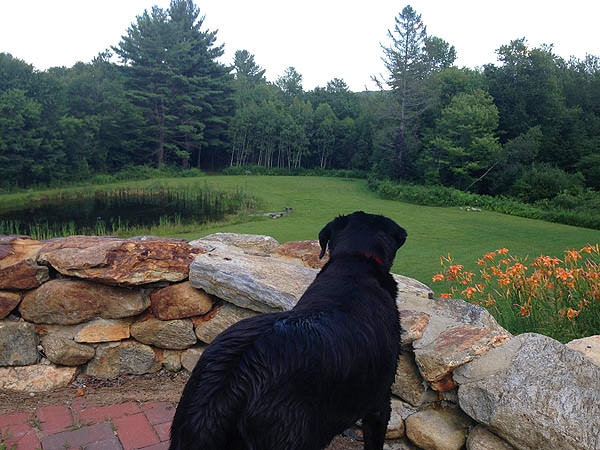
Had a nice conversation with the owners, who had to excuse themselves to make supper. That’s the amusing thing about B&Bs: well, we’re going to make dinner now. No, you can’t have any. They knew Peg; everyone around here seems to know Peg.
Including, as you might expect, her daughter, whom I met for supper at the Dream Away. Great place. It’s just up the road a piece. But which road, exactly? I followed directions, headed west along narrow roads with no shoulders. The road rose and dipped and swerved and hairpinned and rolled up and down the land, and driveways became fewer and fewer. Obviously they’re not going for the drop-in trade. Perhaps I had taken the wrong road. I had certainly gone longer than a piece. Three pieces, possibly four.
Turned around, went back. Checked the directions, and oh ho, my fault. I’d taken Unnamed Route 0, when I should have taken County Road. I’m half serious: the name of the road is County Road. No number. I went back on County Road and drove about nine pieces. No roadhouse.
Through the thick trees I see the sky begin to darken. Okay, I’ve seen this movie. I stopped at - I am not kidding - an abandoned municipal garage, and checked my phone to get the map.
NO SERVICE
Oh, that movie, you say. Right. Well, I turned around, drove until I reached the two-lane Highway 8 - which was the tiny capillary that branched off the two-lane 20, but had now attained SUPER HIGHWAY status in my head because I knew where it was and where it went. Found out how I took a wrong turn, and found the Dream Away.
And left. I was early. But now I knew where it was. Drove to the town and took some pictures. Yes, I think I'm in New England.
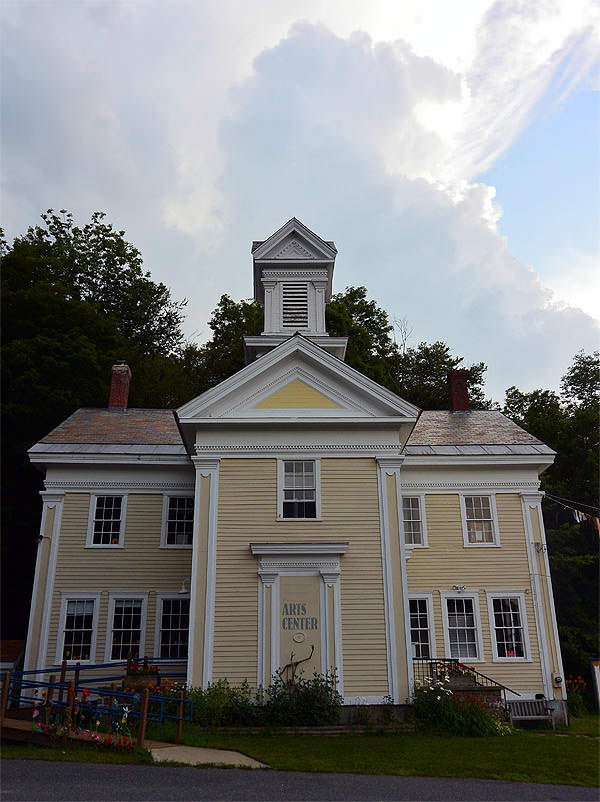
The storm started rumbling above as I was snapping away, and it made everything seem deliciously ominous. There’s a reason Stephen King doesn’t set stories in the middle of North Dakota. You can see the devil coming from a long way off on the plains. Everything here, seems to be around the corner, up the road a piece, but never within plain straight sight.
As for the Dream Away: boho kitsch oasis decorated in Full Eclectic, full of locals and summer people. Astrid was just delightful and funny, and smart, made me feel completely at ease, barging as I was into the family summer. The rain came while we dined and pushed down the murderous temps to something autumnal and chilly, and the scent of a bonfire drifted in the windows to complete the whipsaw shift to fall. Of course, I’d left the airconditioner on in my B&B room. On TEN.
FRIDAY
I drove up 8 to the small town, took a right behind the church, went over a WPA bridge, up, and up the road like a snake trying to throw you off its trail, and finally saw the sign to the house. Another road through spectacular trees ten stories tall . .
. . . to the house. The door opened and there she was, my favorite radio personality AND my favorite radio writer, the Mrs. Edna Babbage of the sitcom, the woman whose work makes “The Lucy Show” and “The Honeymooners” look like silly cartoons.
Peg Lynch.
And here we have to just marvel for a moment, don’t we? Less than a year ago I had no idea who she was. I think I found her show by browsing at random on an Old-Time Radio site, and picked up something quite different from any other show - the faultless comic timing, the way the laughs came from the characters and situations instead of gags, the economical storytelling, the story arcs that gave the weeks and months a shape and direction while allowing for all sorts of unrelated details. Started listening to them every morning at 9:30, as if they were being broadcast. Then, as you may remember, I just called her up. When I picked up the phone and dialed the numbers I thought I’ve never spoken to anyone who did this. Who was there. Who was present during the great days of radio - good Lord, she’s 96, I’ll probably get a nurse or a relative used to scaring off the occasional pesterer. But she answered, and we had a grand chat, and she told me to come to visit.
So I did. And now here I am.
“Give me a kiss,” she says.
The house is quite full - her husband (voted the handsomest husband in NYC, and they have the press clippings to prove it), a few assistants, her daughter, and her grandson. Also a shy collie. And right there, and there, and over there, are things that would make any radio archivist clutch his chest and fear for certain infarction. The clippings. Pictures of old radio friends. Scripts. One of the assistants is sitting at a table, sifting through items bound for the university archives; promo photos, magazines with stories on TV show. It’s like going to visit Jack Benny and there’s a violin on the desk, and yes, it’s the one he played on the radio while Mel Blanc yelled at him.
So. We go to the porch and talk for two hours - stories and tales and items and gossip I’ll save for the various things which will end up here and there. (The paper, this site, and the upcoming official site.) The stories pour out, and a few - I suspect - may have been honed by retelling, and are related complete with professional timing. Well, she is a professional, and timing was one of her gifts. I run out of batteries before she’s halfway to close to winding up the prelude of all she has to say.
Before lunch we watch a few of the TV shows, and this is a revelation. The short pieces she did for the Kate Smith show are just hilarious. No one’s seen these in years; you can’t find them anywhere online. (Imagine that.) The radio humor translated perfectly to television, which was something I didn’t expect. I thought TV would have slowed it down, demanded gags, made everyone pause for laughs, and interfere with the rhythm and interplay. Well, no - and in one piece, a frantic kitchen episode which had to be blocked like two people dancing with imaginary partners in a phone booth, you realize how good she was as an actress period, not just a radio actress.
She said they couldn’t rehearse with props because of Union rules. Someone to bring out the prop, someone else to take it away. They practiced by fussing and pointing and rearranging something that wasn’t there - but would be there when they did it on TV. Live. For millions.
No pressure!
Naptime for the folks; Astrid takes me through some of the scrapbooks. It’s not just the amount of material - reviews, profiles - that staggered me, it was the full account of mid-century media. The bylines, the distant papers, the typefaces, the letterheads from newspapers and columnists. The obligatory Star-At-Home-With-Family spreads, the Christmas cards from the fictional family, a Ripley’s Believe-it-or-Not knockoff:
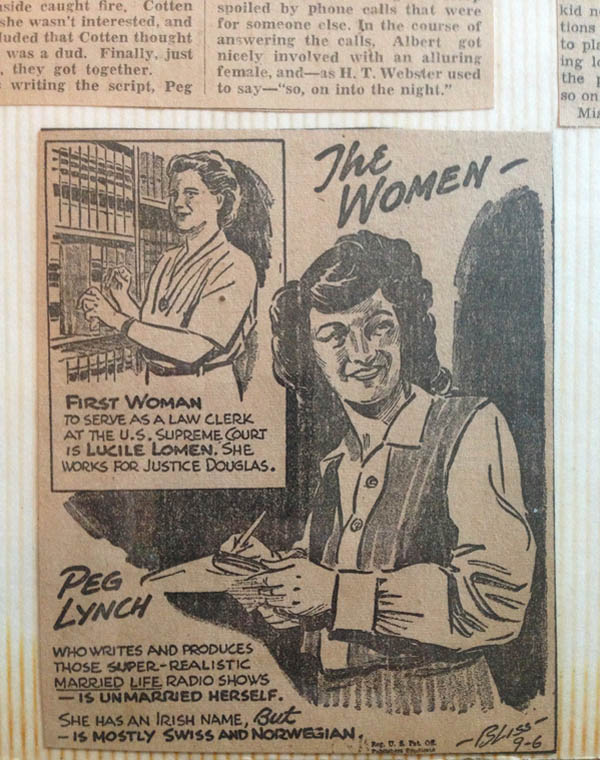
Notes in the TV column:
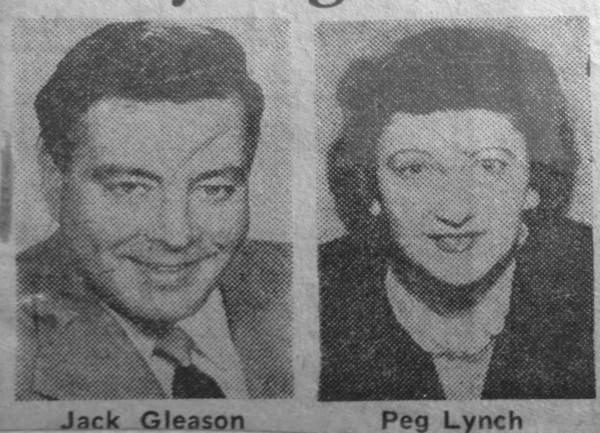
The publicity shots answered a few questions: the studio looked like this . . .

. . . and that was the little girl who played Betsy.
Oh, there’s lots of that.
In the evening we watched one of the Ethel and Albert nighttime shows, a full half-hour taken from the kinescopes. Again, just to put this in perspective: imagine you’ve discovered the old Dragnet radio series, found it fascinating, then discovered there was a TV version, then ended up in the kitchen watching it with Jack Webb. Like that.
Then dinner, and anecdotes about someone named “Thurber” and some lady named “Mrs. Roosevelt” and how she kept running into her.
One other note. On the way up yesterday I listened to the daily episode, a post-Thanksgiving show. (Also listened to an ep from “The Little Things in Life,” the 1970s incarnation of the show, that had someone else playing Albert. It was like going home a few years after a parent died and the other remarried - you’re glad for everyone, how it worked out, but it’s just not the same. I listened to some early and later “Ethel and Albert” shows, which preceded “The Couple Next Door,” just to bring myself up to speed on the tone of the various endeavors.) When we were looking through boxes of scripts, I asked if #240 was around.
Of course, it was.

SATURDAY
Another day much like the other - an hour or two of conversation, this time in the kitchen, the flow of stories and details and names, lunch, the afternoon show. It’s one thing to watch a 1950s sitcom that has not been seen since it aired - and let me just repeat that, and let it sink in: has not been seen by the general public since it aired.
And it stars . . . .
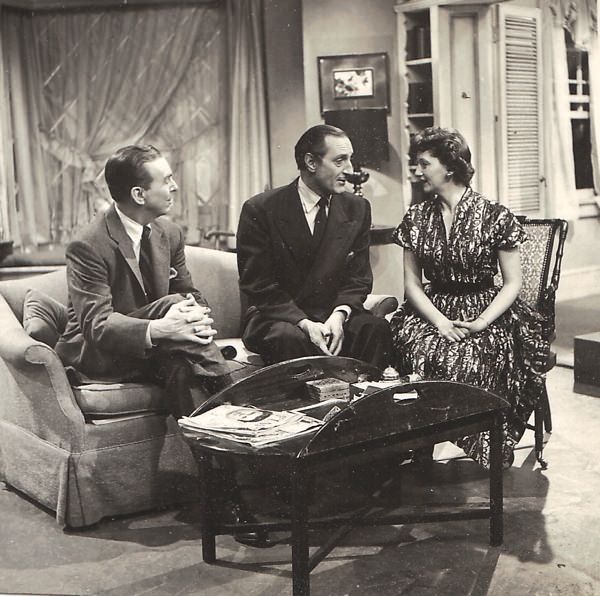
BASIL RATHBONE. Who was hiliarious.
“What was he like?”
“Broke,” she said, because at the time his wife just took everything he made and spent it three times, but he was a terribly decent man from the sound of it, and she took him to Schraft’s and bought him lunch when he was in town. Basil. Fargin’. Rathbone. And so I’m halfway between the screen and the author, and just drinking it in. She wrote him perfectly - almost wordless in the first part, the very picture of mortified dignity, and then delightful and cheerful and genuine in the second part, a man who bonds with the small-town family over Scrabble and pictures of his daughter. “I wrote that into the script after he showed me pictures,” Peg said. She took the conversations they had and turned them into the simple brisk scene that humanized the imperious Sherlock.
We watched the commercials she did for Wisk. Part of the 1958 GM special - and therein hangs a tale, believe me.
During the afternoon nap, we set to work digitizing some of the interviews, and scanning a heap of tiny pictures of the E & A set that sat in a tiny plastic box on a grand piano where, I later learned, a fellow named Bernstein sat down to play once. The pictures are half candids, half publicity shots, but when blown up, you get a moment in time that leaps out with nice crisp enthusiasm:
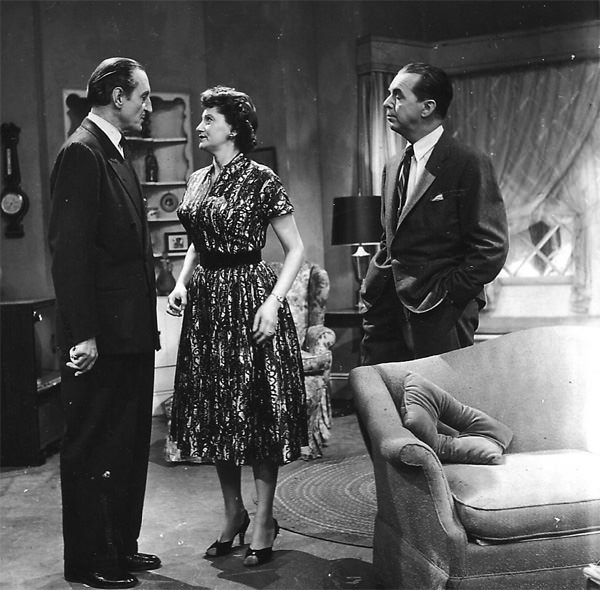
As Astrid pointed out, a lot of the set ended up in their house. This table . . .

. . . was in the kitchen. My laptop was sitting on it. Yes, that's Margaret Hamilton, the Wicked Witch of the West But Not Really When You Got to Know Her.
At one point I remembered something I got off the web: an episode of the show that ended abruptly, went to silence, then returned with open-mike recordings from 1945.
The piano playing made me wonder when I first heard it: they had a piano in the studio? I suppose they did. Someone sat down and played to while away the time.
Astrid said it was her mother playing. That was something she used to play.
Voices come up; the tape fades out. Several hours later, after dinner, I remembered it. Called up the webpage on my phone, cut ahead to the end of the piece, played it for her. She leaned over, hands cupped behind her ears, and listened, hearing the sounds of the studio where she worked 65 years ago. Then the piano.
“I don’t think that’s me,” she said.
There were a few stumbles, some chunky chords.
“That’s me,” she said.
We sat in the kitchen with the sound of her music coming out of the phone, and she smiled it hear it all again.
And so I use this art, which I've employed for the music for her show, for something else.

I checked the list of stations in one of the scrapbooks. Ah hah: The show ran in Fargo. My Mom had the radio on all day to keep her company. This was exactly the sort of thing she would have enjoyed. I never got the chance to ask her if she listened. Driving home that night I wished again I could just pick up the phone and talk. Mom? Hey, I had dinner at Peg Lynch’s house! I'm serious. She’s just what you’d expect.
You would have loved her too.
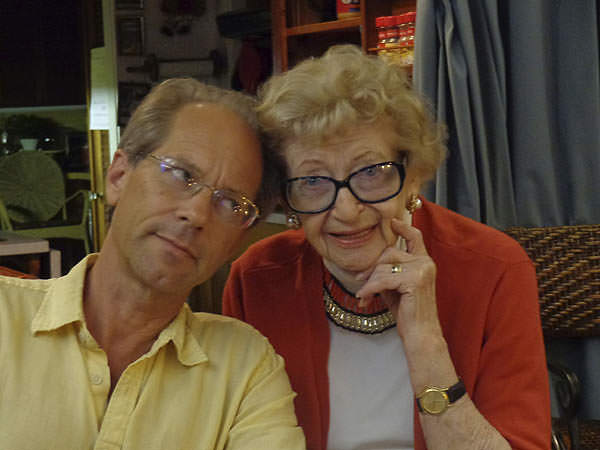
----
TOMORROW: Well, some more, of course. Odds and ends. See you around.
|